#jonny’s insect catalogue
Text
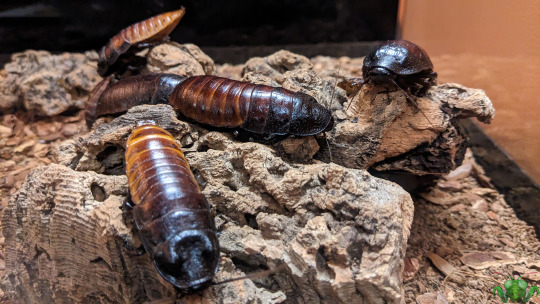
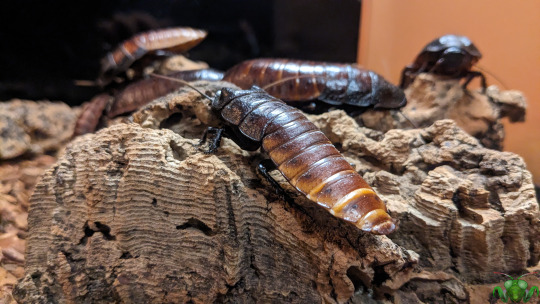
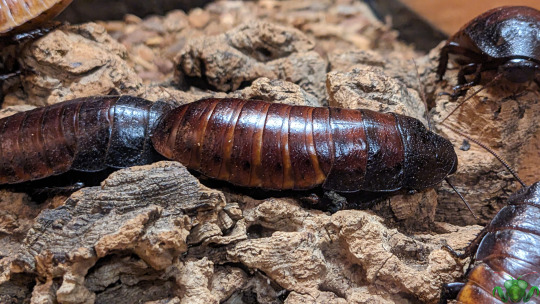


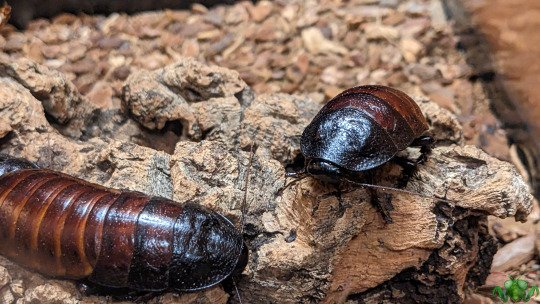
Madagascar Hissing Cockroach - Gromphadorhina portentosa
With this set of insect images, all pictures from the ROM for the year 2023 are proudly displayed on this blog for you to enjoy. I've already gone at length discussing these feisty beans and their habits, behaviors and routines. While many onlookers may not see these armored insects as appealing, I take great knowing the role that they have within their own ecosystems and the opportunities they provide for eager minds to learn, whether as pets or in exhibits. It could be worse if you're not a Roach fan: as this specie lacks wings, it can't suddenly startle you by becoming airborne and (unintentionally) buzzing towards you. They can run rather quickly, however! Having visited this exhibit many times before, it would be a benefit to have additional information displayed regarding these curious insects.
Though simple, there's so much to learn about them, and many myths that can be dispelled so as to not treat all Roaches as "dirty insects" (admittedly these species does consume debris and rotting material as they are decomposers by nature). An interactive series of hissing samples would provide a lot of insight into how they interact and communicate with each other and the other creatures they encounter. Perhaps hearing it live is more authentic, but in a carefully curated environment such as this one, agitating the exhibit denizens for spectacle wouldn't be the best idea. Besides, a sudden hiss from such a small creature is quite startling the first time, especially if you're not expected it. It's up to the Cockroach to determine how aggressively it will press air from its spiracles.
Pictures were taken on December 19, 2023 with a Google Pixel 4. Please go and visit the bugs.
#jonny’s insect catalogue#ontario insect#roach#madagascar hissing cockroach#cockroach#blattodea#insect#ROM insect#royal ontario museum#insect exhibit#toronto#december2023#2023#nature#entomology#invertebrates
24 notes
·
View notes
Text
more like a weaver, myself
Fandom: The Magnus Archives
Words: 2377
Chapters: 1/1
Summary: The Web knows how to wait, how to play the long game.
Or - Jon Sims was marked by his first encounter with the paranormal, more than he knew.
Warnings: Canon-typical spookiness and manipulation
Can also be read at AO3 here
The boy is afraid. This is not strange – it is good, in fact. The boy should be afraid. It wants him to be afraid. Limbs paralysed by fear are so much easier to twist than those that fight back. It wouldn’t be much of a fight either way, of course. Not for it.
The boy is small, a full head shorter than the children he stumbles past, and spindly. His long fingers linger over the corner of each page before he turns it, and his feet find their way unerringly over the uneven path, eyes never once leaving the page. He doesn’t see the fine strands of web looping themselves around his ankles, tugging his feet into place; but then, he wouldn’t be able to see them even if he knew to try.
His name is Jonny, a frustrated huff from the mouth of his grandmother; or young mister Sims, fond and exceptionally dry from his neighbour; or freak, muttered and unheard by a couple of children that watch him pass with narrow eyes; or little Einstein, from the boy that slaps the book from his hand.
Or mine, from the Web.
But the book is in new hands now, larger, and already marked with little burn scars from a lighter tucked in a back pocket. If left, this boy would wander close to the Desolation, may even be claimed. Normally, the Web wouldn’t notice. The sort of people drawn to the flames weren’t the sort of people it wanted to pull in, but this is different. This is an interruption. This is an insult.
The threads around this new boy draw tight, far tighter than they would have had to around Jonny Sims mine. This boy would fight, if he were capable. Jonny Sims mine would follow his desperate curiosity to the ends of the Earth with little more than a guiding tug here and there to shift his attention. It would have been so easy to lure him in; an odd feeling here, the imitation of a mystery there. But now the connection is stretched thin – not broken, not quite. Weakened. Easier to ignore.
Jonny Sims (mine) doesn’t ignore it. He follows the little insect of a teenager, every one of his limbs tight with fear, breath short. He shivers – he hasn’t noticed that he isn’t wearing a jacket, or shoes. That he’d wandered out of the house, past his grandmother asleep in her armchair. She won’t wake until it is too late.
He follows, two steps behind, down every narrow little twisting road. His eyes never leave the boy ahead, never once glance at his surroundings, but the Web can feel the way he catalogues information as he goes. All the little background sensations, the smells, the sounds. He files it all away in the very back of his mind to pause over later. The Web approves, as much as it is able. Though information, watching, is every part the domain of Beholding, manipulation is impossible unless you know at least the shape of a person; even the vaguest outline. Its Jonny Sims is too straightforward for any such machinations as he is. There is potential there, but for now he is too demanding, too impatient. The Web moves slowly, at a pace that it thinks would frustrate him.
Not that it matters, of course. It would be nice to have him alive, but it’s in no way a necessity.
Jonny Sims miiiiiine stops in the middle of the road when the teenager reaches the door. He stands well back, shivers running up and down the length of his body now. He does nothing but watch as the door opens, as the Web reaches out one of its many, many legs to this scrap of a meal. His eyes are wide, with mingled terror and sickened fascination.
He stares, and stares, and stares, until the door shuts again with a soft snick, and he never once notices the gossamer threads curled around his fingertips.
The Web never loses him. Of course it doesn’t. But the Web is patient, in its own way, and it doesn’t have a need for him.
It may never need him. That isn’t the point.
It doesn’t help him when he finds the application for the Magnus Institute – a research position, pinned haphazardly to the board outside his professor’s office – but it also doesn’t try to stop him. Jonny Sims (who goes by Jon now, which fits his severe features and clipped tone, but not the nights he still wakes on a flinch, the feeling of phantom legs curling around his chest, his arms, into his hair) is still as insatiably curious as he had ever been. The Web isn’t surprised that he would be so quickly enamoured with the Beholding’s stronghold – even if serious, straightforward Jon would never think to use such a word when describing himself.
The Web also isn’t worried. Its threads have never let him go, over the years, its many eyes following him. But it has thousands of other threads, all tugging at its attention, all clamouring for its notice. There are others out there it watches, that are wrapped up far tighter than little Jonny Sims. It can’t focus all of its energy on him – but it also knows that Beholding will be content to watch, and watch, and watch, and do nothing else, even when a man with silvery cobwebs woven through his hair crosses the threshold for the first time.
Of course, the head of the Institute notices; he Looks through the mind of Jonathan, quick and light. Sees the book, the door, the low-level fear and disgust inspired by even the thought of spiders ever since. Sees it all, and dismisses it as unimportant. Either the Beholding will claim him as its own, here where it is strongest, or he will die quickly enough. That’s how it always goes; mostly in the Archives, but throughout the rest of the Institute as well.
And so, Jonny Sims – mine, mine, MINE - starts his new job at the Magnus Institute, London.
The Web can feel it, when Beholding takes notice. That’s fine. He belonged to it first.
Things get complicated eventually, because of course they do. There is, to an extent, some level of protection that is implied by Jon’s position as Archivist. It is not complete – of course not, the Beholding doesn’t go around claiming people, that would be far too much like interfering – but it does make it harder to strengthen its own hold on him.
So it has to improvise a little.
It had known what Elias Bouchard was planning for a while, and Elias Bouchard had known it had known. It had known what would happen to Jonny Sims when he disappeared down and lost himself among the statements, and it found itself repulsed on a deep, vicious level. How dare he?
It can’t stop him – manipulation of a thing like Elias Bouchard is exceptionally difficult, and utterly impossible without some element of surprise. Something that it lost the first day Jonny Sims MINE had walked into his office. Its Jonny Sims will be the Archivist, and that is that.
Except.
There are many, many pieces in motion already; it is the work of half a thought and mere moments to shift a couple around, and tug a flyer enticingly in the wind, to pull someone two steps forward to clear a line of sight, and let it catch the eye of Martin Blackwood without ever once touching him.
Martin introduces himself the first day, standing in the threshold of the Archivist’s office, stammering and unable to meet the eyes of his immediate boss. A furious flush colours his cheeks and spreads patchily down his throat that it notes with – not interest, exactly. But it notes it all the same. No doubt it can utilise that, at some point.
He is taller than little Jonny Sims – even if Jonathan were to straighten out of the terrible hunch he maintains over books, laptops, the morning paper – and broader too. He is nothing at all like the sour faced and wiry boy the Web almost caught all those years ago, but that same curiosity sits on the back of his tongue. He is immediately taken with the sullen, scowling face, and the Web feels a little surge of triumph at its choice. It won’t take long for Martin to do anything for its Jonny Sims, even though his first impression is a deeply displeased twitch of the mouth and a curt has no one told you it’s polite to knock?
The Archivist barely glances up from his notes, even as Martin manages to make his apologies. Not when he returns with a tray of tea and biscuits, and carefully knocks on the doorframe, tray precariously balanced on one arm. Only takes the mug with a muttered thank you, not even glancing at the spiderwebbed pattern of cracks in the glaze.
It is, it feels, an excellent start.
It likes Martin, insofar as it can like anything. He is useless to it on his own, of course, with no innate fear of spiders, and a certain dismissal of manipulation; like he thinks he is far enough below anyone’s notice as to be not worth the time or effort put into such a thing. But he is a grounding presence, soft and warm and human, and never shoos away the spiders in his apartment. He will be good for Jonny Sims (the Archivist now), good at drawing him out of the confines of his own head, and the heads of the people on paper.
And – more importantly – Elias Bouchard will never think to look twice at him.
The others leave their marks on its Jonny.
Scars.
Fears.
Statements.
Oh, it doesn’t like that. It doesn’t like that at all.
For all that Elias Bouchard likes to think of himself as all-seeing, for all that he boasts of knowing everything that happens in his Institute, he never notices the odd little cobweb here and there. Nowhere he would frequent, of course. Nowhere he would think to look too closely.
Places like the stationery cupboard. The second-floor bathroom that always has at least one tap not working. The tea room.
It watches and listens, contents itself with occasionally scaring an employee half out of their wits as they turn around and spot a fat cardinal spider on the wall that seconds ago had been empty. Although he isn’t watching for it, even Elias Bouchard would notice if it stole away one of his employees.
It waits.
It doesn’t quite have all the time in the world, but it at least has longer than the Stranger.
It’s proud, in its way, of Martin Blackwood. He shows remarkable aptitude for the sort of twisting thoughts and careful, delicate traps it prefers. It likes, as well, to see its lighter put to good use. A gift for its Jonny Sims, originally, but this pleases it very well too, watching the statements go up in flames from eight little eyes in the corner of the room. It had started to get bold, when it realised what they were planning. When it realised the sort of danger Jonny Sims – no NO MINE MINE! – was about to put himself in.
When it realised Elias Bouchard wouldn’t be a problem for too much longer.
It knows – or is fairly certain, at least – what will take over his role as the head of the Institute, and it knows it has little to fear from the Lonely. So wrapped up in their own little heads, and their own wide worlds, the Lukas family never notice anything it doesn’t want them to. Slipping under that radar will be child’s play.
But still, it doesn’t quite have all the time in the world. As much as the thought repulsed him, its Jonny Sims took to the role of Archivist like a fly to a web – struggling and terrified, but inevitable. Caught all the tighter for his thrashing. Almost resigned to his own consumption.
And that won’t do, not at all. As he gets pulled in deeper to the mess of dreams and statements all knotted up inside his head, its threads pull taught, threaten to snap. It can’t have that, not at all.
It has its ideas, though. Its plans. Now there is no Elias Bouchard to keep a watchful eye over the Assistants, and Peter Lukas wouldn’t know what to look for.
It watches the despair begin to overtake them. The two women don’t come to visit its Jonny Sims often, and when they do, they are tense. One – tall, with hair scraped back from her face at all times – clenches her jaw so tight the muscles bulge, like she wants to shout. Sometimes she does. The nurses here know better than to interrupt. That one is very good at masking fear as fury.
The other – lighter on her feet, with tired, tired eyes – says very little, only sighs and tucks a tape recorder into her bag for each visit. Just in case.
Martin’s fear is palpable, though. It’s almost thick enough to see in the air, and often flavoured by tears. He visits more than anyone else combined, and will sit for hours, apparently content to do nothing but read heavy tomes bound in suspicious materials, and occasionally point out what he considers an interesting passage to the unresponsive Archivist. Days go past, then weeks, and he visits no less, although he stops chatting about the books he’s reading, stops muttering to the Archivist about how much he is needed, stops – well. He doesn’t stop trying, but he does stop hoping. It sees the moment something in him settles, when he makes a decision.
It starts to weave.
There is more grey in his hair now, and the delicate pattern of veins under his skin looks different. His eyes, when they open, are for a moment black from lid to lid, before he blinks and they settle back to bloodshot sclera, rich brown irises, pinprick pupils. The room is empty besides him, and a little money spider making its home on the window.
Jonny Sims breathes, blinks all of his eyes, and wakes up.
#tma#magnus archives#I wrote a thing!#I know I was surprised too#first time posting a fic to tumblr let's see how this goes
6 notes
·
View notes
Text
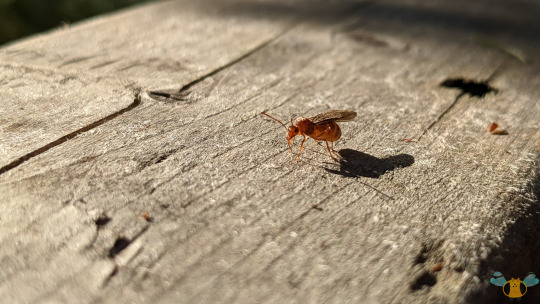
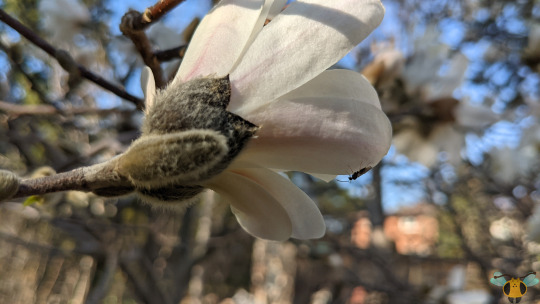

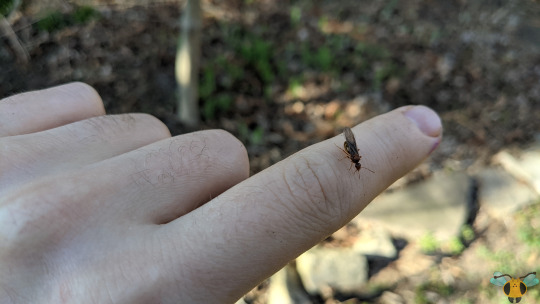

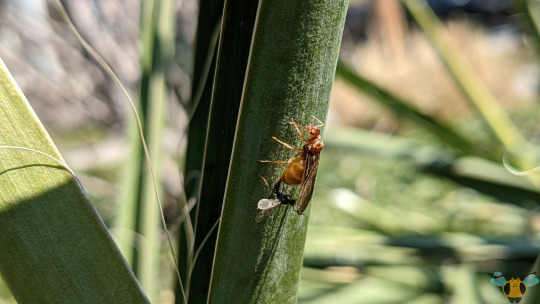
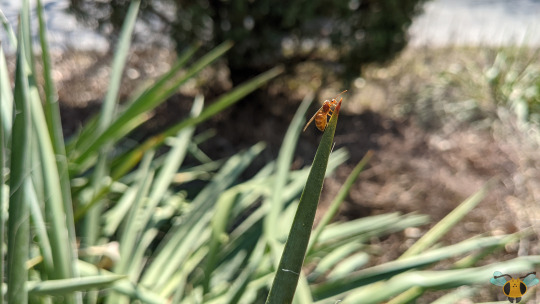
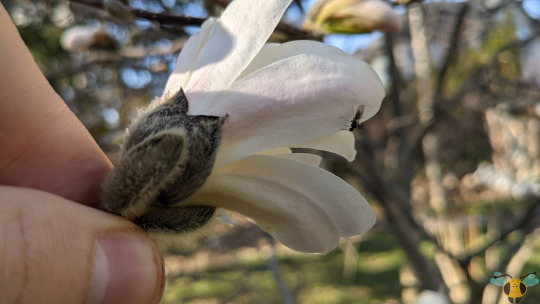


False Honey Ant - Prenolepis imparis
Let's briefly revisit these mismatched individuals and be reminded of the warmer days of spring and nuptial flights. Though of different sizes and forms, the Ants in these pictures are the same specie, but are simply designed for different purposes. All the smaller winged male Ants here must do is secure a female and successfully form a mating pair with her. After that, his job is done and that'll be the end of him. At least he gets to enjoy the sun and breeze as he does so, as other species of Ants may have to venture underground to find a mate. Those that do are heavily scrutinized by queen's workers, and should he be deemed unfit, he will be carved apart and converted into food for the colony. If he's lucky, it will just be the wings that are eaten (first). Meanwhile, the swollen female has a long life ahead of her, especially when she finds a suitable colony location deep within the ground.
When the queen is ready, she will have shed her wings and shall foster a wonderful home teeming with loyal subjects and defenders by suppling an egg output thanks to the male's contribution. With a fill of resources inside her abdomen, she has all the energy she needs to facilitate a nest and the first batch of workers. Do not be confused however, she is full of fat reserves, not honey (unlike true Honeypot Ants such as Myrmecocystus spp.), hence the name "False Honey Ant". As the fat reserves begin to dwindle, however, sclerotization of exoskeleton progresses, as can be seen in the winged queen in Picture 9. As such, these young queens have time, but not unlimited time to find a home. I hope to see the nuptial flight this year if I can, but the emergence can be somewhat unpredictable. What is predictable however, is that this Ant will likely emerge earlier than other species as they are more tolerant of colder temperatures. They are so tolerant in fact, that they may even forage during winter, provided it isn't too cold and snow doesn't impede their locomotion.
Pictures were taken on April 8 and 10, 2021 with a Google Pixel 4.
#jonny’s insect catalogue#ontario insect#ant#false honey ant#hymenoptera#insect#mating pair#april2021#2021#toronto#nature#entomology#nuptial flight#invertebrates
22 notes
·
View notes
Text

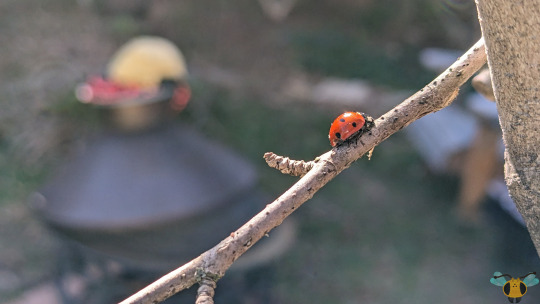

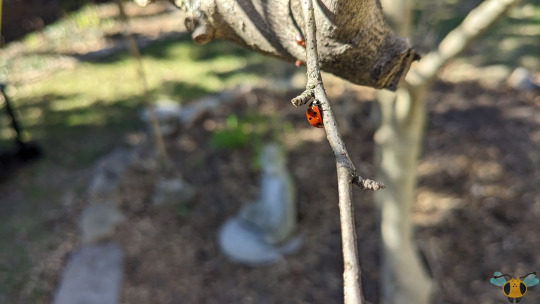


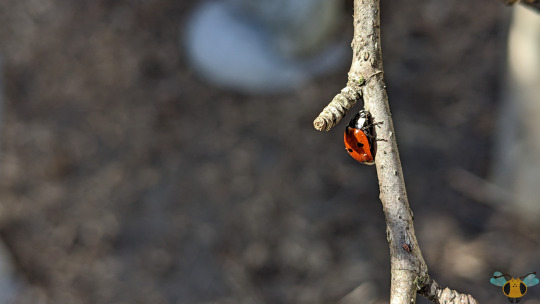
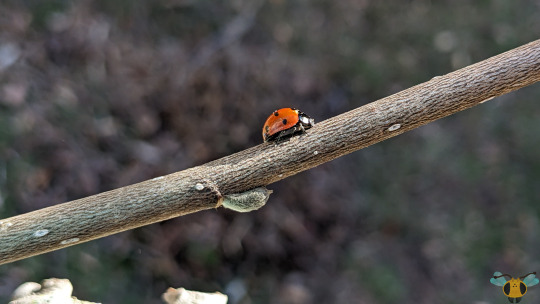

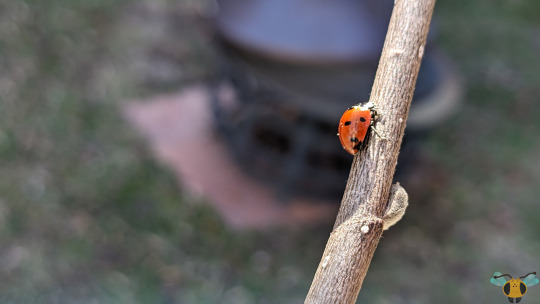
Seven-Spotted Ladybug - Coccinella septempunctata
Spring is starting to take full effect in Toronto. With the warmer weather, the greenery is returning to life, buds are beginning to open and the insects awaken. In particular, I found this small jewel climbing up our white magnolia tree which was on the edge of blooming. Unbeknownst to it, this curious Beetle was actually on a fallen branch that wasn't attached to the tree, but it eventually found its way to more stable ground. No danger of falling of course since Ladybugs are built tough with a strong wingcase and (obviously) they can fly. When a Ladybug is active so early in the spring, it's relying on smaller soft-bodied insects to do the same in order to sustain itself. Moreover, it's also relying on plant-life to be growing in order to sustain those insects. If there's nothing nearby, it fly on to the next area and search The ecosystem can be very complex and this Ladybug is but a small piece of it, but as everything begins to grow again, a Beetle like this can whittle down a few pest insects and ready a summer generation of hungry Aphid-consumers. It's just a small sample of what a new year of insects will bring.
Pictures were taken on April 7, 2024 with a Google Pixel 4.
#jonny’s insect catalogue#ontario insect#beetle#seven spotted ladybug#ladybug#ladybird beetle#coleoptera#insect#toronto#april2024#2024#nature#entomology#invertebrates
13 notes
·
View notes
Text





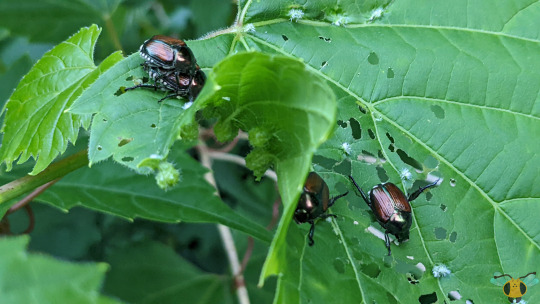
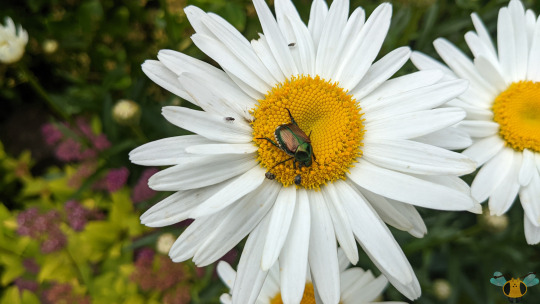
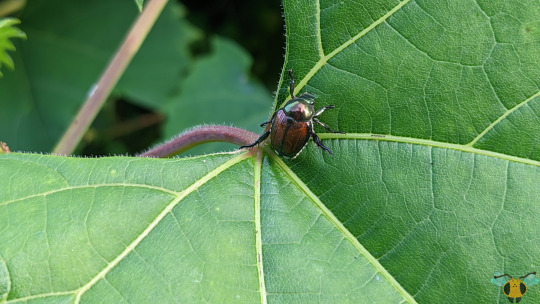


Japanese Beetle - Popillia japonica
After a long absence, these brassy emeralds make a triumphant return to the blog! They've been long overdue, especially since I mentioned in their first post (back in 2019) I would be showing the larger populations that can be found in the neighborhood. Now granted it's not a dramatic increase, but there are many individuals here enjoying the leaves of the suburbs. As can be seen here, these hungry Beetles ignore the leaf's most prominent veins and nibble (somewhat sporadically) on the leaf itself. As generalist feeders, they aren't picky about which plants they land on so long as they are accessible and nutritious. As well, they really love fruits and flowers too! Why, it even seems one individual may even have struck gold with a daisy's pollen...and likely the flower itself if my photo evidence of rose eating remains valid. Given this information, be sure to identify them with certainty if you find them in a flower. The slightly elongated St. John's Wort Beetle is eerily similar at a glance, and yet it's from an entirely different Beetle family.
All the hallmarks of this Scarab Beetle are featured here: leaf skeletonization, iridescent shells and raising their hindlegs to act as a threat display. With regards to the latter, it may not be so readily apparent why the display is a threat. It honestly looks a little silly. However, a vigilant glance at the hindlegs reveals spines just before the midleg. I cannot speak on their strength to pierce or puncture (perhaps a post for a later day) but spines like that are a handy advantage if grabbed from the rear. Speaking of leg observations, looking are the front-most legs can actually allow you to determine if you have a male or female Beetle in your presence. If we use the mating pairs as a reference - since females are mounted by the males - you can actually see that the female Beetles have an elongated, rounded projection jutting out of the end of their tibia! In males, this feature is reduced. Knowing this information, the individual crawling along the daisy is in fact, a female specimen! You can see the tibial projection on her left leg. Do you think the Varied Carpet Beetle next to her noticed?
Pictures were taken on July 1 and 8, 2022 with a Google Pixel 4.
#jonny’s insect catalogue#ontario insect#beetle#japanese beetle#scarab beetle#coleoptera#insect#mating pair#july2022#2022#toronto#nature#entomology#invertebrates
13 notes
·
View notes
Text
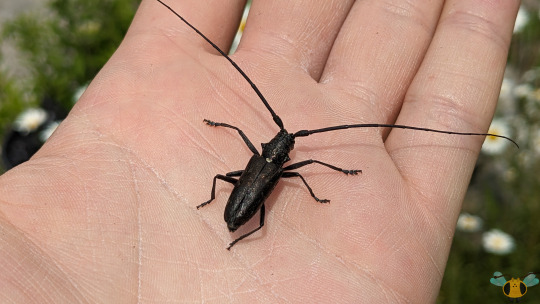

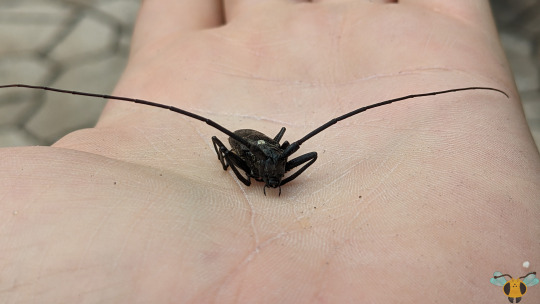


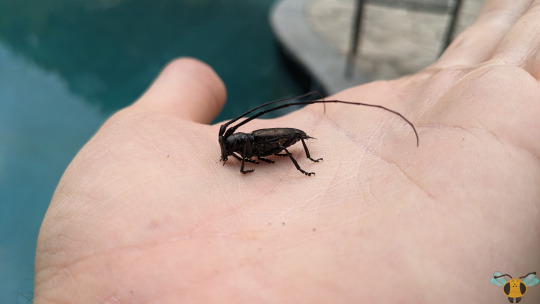
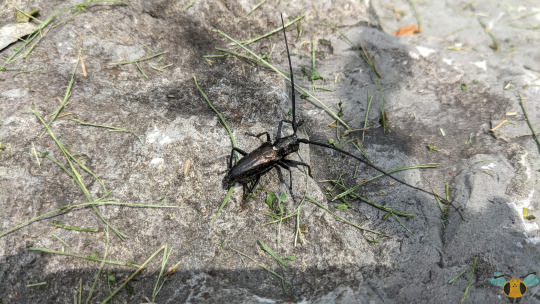


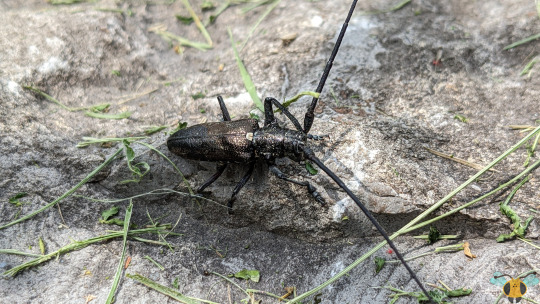
Whitespotted Sawyer Beetle - Monochamus scutellatus
This insect has already been thoroughly examined and explored in the previous post that featured it. As such, for today's post, please a few more pictures of this hardy Longhorn Beetle that survived a tumble into a cottage pool thanks to quick intervention. If you seek one in North America remember the following tidbits of information:
Since it relies on forests for its diet and egg-laying, look there to find live specimens. Check the bark and needles of cut/damaged pine, spruce and other varieties of conifer trees. They are attracted to the scent cues and may also be found after fires
It is a North American native, the ecosystem has had plenty of time to adapt to it, and the Beetle itself doesn't appear to be a major pest
To identify it and distinguish it from its relatives, look for a white scutellum (between the wingcases) and pronotum "shoulder" spikes. It is also rather slim with a slightly widened abdomen
The elongated antennae are hard to miss; they are easily 2-2.5 times the length of the body
If the antennae are ringed and/or the wingcase features white patches, the specimen is something else (see Citrus Longhorn for details)
The larvae may be trickier to find since they hid beneath trees, but they are apparently noisy, hence the name "Sawyer"
The adults have formidable jaws as well, but are unlikely to do anymore than pinch. Nevertheless, handle with care
I really enjoyed observing this insect during the summer of last year, and I'm glad it could be saved from a pool. It still needed some time to recuperate before it could move again, but Beetles are very resilient! Having said that, I'm very fond of Picture 2, where it looks like the Beetle is trying to pull itself up again, but is too exhausted to fully stand. I didn't pose it that way, that's just the way it landed on the nearby stones. For a general timeline of handling this insect from the pool: hand pictures first, stone pictures afterwards with Pictures 7 and 10 showcasing the Beetle regained its strength to move again.
Pictures were taken on July 1, 2023 in Caledon with a Google Pixel 4.
#jonny’s insect catalogue#ontario insect#beetle#whitespotted sawyer beetle#longhorn beetle#coleoptera#insect#caledon#july2023#2023#nature#entomology#invertebrates
14 notes
·
View notes
Text
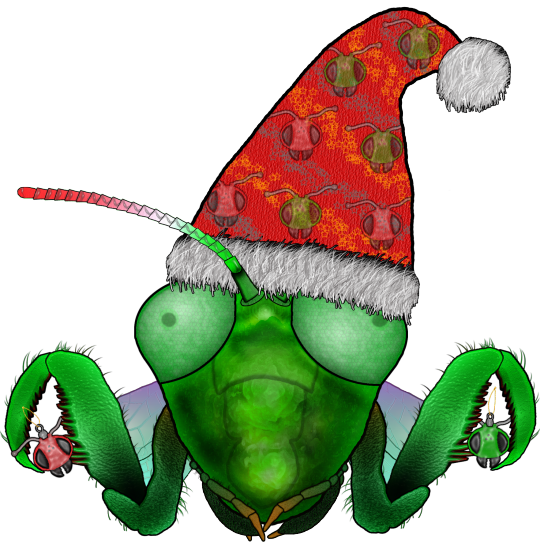
Merry Christmas!
For the winter holidays, I've taken the blog's Mantis logo and tried to shine it up with the spirit of the season. Our Mantis friend now dons a Santa Claus fur hat that is decorated with a Bee logo pattern of green and red & gold and silver stars (intended to evoke tinsel). I suppose you can him "Mantis Claus" or "Mantis Claws". There were attempts to change the Mantis' color and to add decorations to the body, but the attempts made it look somewhat sinister so I abandoned the idea. Simplicity was the better choice this time, as was the necessity to have a bit of fun with this logo! One antennae is poking out just to keep things light and fun. Alongside the hat's pattern, the Bee Logo is included here in the form of red and green ornaments clutched in forearms of Mantis Claus. For future posts, this logo will be included in the text of Christmas related posts, and earlier posts have been updated to feature this bit of artwork. Even in the coldest winter, insects can always add a little touch to celebrate the season. Stay warm.
Done in Photoshop
#jonny’s insect catalogue#art#mantis head#logo#photoshop#blog logo#siteart#entomology#entomology blog#nature#nature blog#blog art#christmas#merry christmas#merry christmas 2023#happy christmas
15 notes
·
View notes
Text
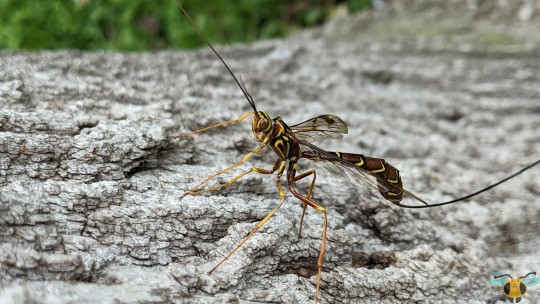


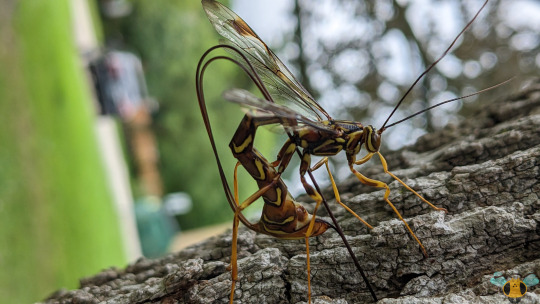
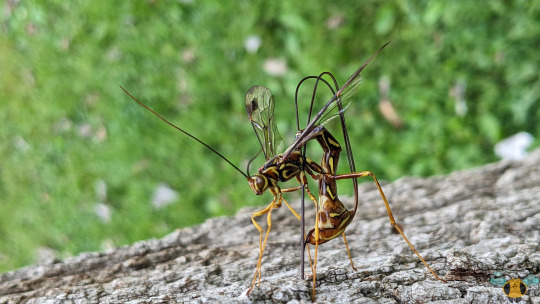




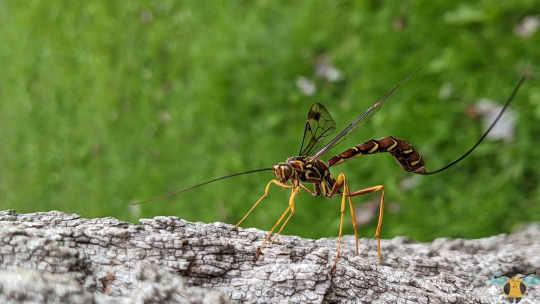
Long-Tailed Giant Ichneumonid Wasp - Megarhyssa macrurus
To anyone wondering why this giant wasn't included in the "Insect Highlights of 2023", it's simply because there were enough pictures taken to allow a second showcase! She's a very impressive creature, and I'm fortunate to have found her last year. I hope to find a few more specimens in the future, especially if they revisit the tree this one was exploring or similar trees in the surrounding area. As a reminder, Giant Ichneumonids like this specimen are drawn to old, decaying trees in search of Pigeon Horntail larvae for their own eggs. Using their elongated ovipositor they pierce through the wood like a syringe, paralyze a developing larva and place an egg on it. This whole process is done without even so much as seeing the larvae hidden in the tree trunk, but they are searched for via scent cues on the bark, listening for sounds via her legs and feeling for them with her sting as it is pressed downward! Though it looks unwieldy, it is surprisingly easy for an Ichneumon Wasp of this size to orient itself to "drill for larvae". When she's decided on a suitable location, she extends her abdomen and legs as far as they will go, orienting her ovipositor to be as vertical as possible! Since the ovipositor is long, it will take a series a fine adjustments to pull it in so that it lines up parallel to the abdomen.
After it is pressed into the tree trunk the ovipositor is fully unsheathed and the Long-Tailed Giant's search proceeds. The individual in these pictures had just begun to drill for larvae (and had re-sheathed upon my return 1 hour later) Although it may seem precarious, it's important to keep in mind that the ovipositor (which can be more than twice the length of the insect’s body) is not a stiff filament. It appears stiff while inside its sheath and carried behind the insect under normal circumstances. In fact, it is somewhat flexible and can be maneuvered around tree-bound obstacles while searching for larvae. The flexibility also offers an easier exit when withdrawing from the hole in the tree, but not a hasty one: should the ovipositor became damaged, the Wasp will not be able to lay eggs, so withdrawal is monitored carefully. If you'd really like to see an unwieldly "stinger", try and observe an Ichneumon flailing the ovipositor around and place it smoothly back inside her sheath! Do not fear when observing this imposing beauty; though the ovipositor is long and prominent, her "stinger" cannot harm a human. As you've read above, her stinging process requires a lot of telegraphing to be effective, and Ichneumonid adults are not predators nor are they interested in humans. Though Wasps, there is a world of difference between Ichneumonids and some of the more common social Wasps of Ontario.
Pictures were taken on August 24, 2023 with a Google Pixel 4.
#jonny’s insect catalogue#ontario insect#wasp#ichneumon wasp#long tailed giant ichneumonid wasp#megarhyssa macrurus#giant ichneumon#hymenoptera#insect#toronto#august2023#2023#nature#entomology#invertebrates
15 notes
·
View notes
Text
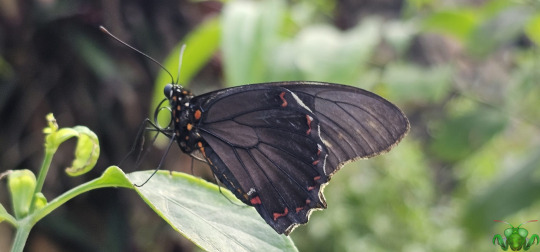
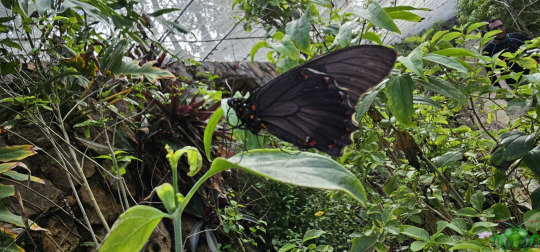

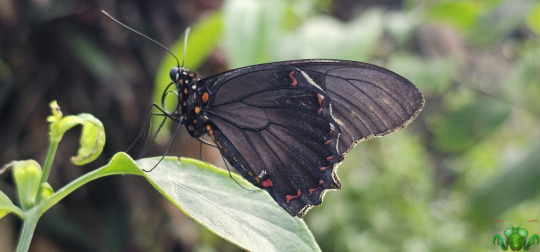
Polydamas Swallowtail Butterfly - Battus polydamas
Though lovely this dark-winged Butterfly is, I'd have loved to see the dorsal side of its wings. Nevertheless, I won't complain too much given these pictures come from a long way from home and from a dear friend who has given us a glimpse to some tropical insects. This dazzling specie features pronounced veins and prominent red markings along the edge of the underside of the hindwing. The forewing features a yellow band that rides along the wing (but not to the edge) both above and below. It's similar to the band of the male Eastern Black Swallowtail but positioned lower on the wing and less steep in shape. The band appears somewhat faded on the underwing, hence why I would have liked to see the dorsal side. The Butterfly's body itself can be easily recognized from the coat of orange-red dots it wears and a similarly colored stripe running along the abdomen (which is partially visible in Pictures 1 and 4). With all these observations in mind, similar to the aforementioned Eastern Black Swallowtail, this specie may be mistaken at a passing glance with the Pipevine Swallowtail (a close relative: Battus philenor). Red spots or white spots, only a landing will tell, as the Pipevine has a royal blue shroud atop its wing scales (if male). Based on location, this individual is likely of the western group (subspecie B. polydamas polydamas), but there are many subspecies in the Central America range so I can't be sure.
It truly is a beautiful insect, and it maintains those stunning colors all throughout its entire development from Caterpillar to Butterfly. From the images I've research Polydamas Caterpillars are plump and dark (dark brown to black range) with a coat of orange spikes along their body and two long protrusions near their head. Such an appearance not only looks fearsome, but can also lead them to be mistaken for B. philenor Caterpillars. From the images I've looked at for comparison, the Polydamas Caterpillars are far more elaborate in appearance. However, when metamorphosed into Butterfly, there is one thing that is sure not to be missed on this specie...or missed, actually as the case may be. Contrary to some of its more popular relatives, this insect is also known as the Tailless Swallowtail! Unlike the handful of Swallowtails* that have graced this blog, there is a complete absence of hindwing tail, and appears to be the only specie in North America to feature tail absence. While these tails are beautiful to observe, it was enlightening to learn just how large the Papilionidae family was and how many Swallowtails actually lack tails. For example, the Palawan Birdwing (Trogonoptera trojana) is a Swallowtail (Birdwing), and though magnificent in size and iridescence, it too lacks tails. That's just the way the wings form within some branches of Lepidoptera.
*Note: As a Swallowtail, you can actually see all 6 legs active and strong, compared to the 4 active legs of the previous two tropical Brush-Footed Butterflies.
Pictures were taken on February 11, 2024 in Mexico with a Samsung Galaxy S23 Ultra.
#jonny’s insect catalogue#butterfly#polydamas swallowtail#tailless swallowtail#swallowtail butterfly#lepidoptera#insect#mexico#february2024#2024#nature#entomology#invertebrates
13 notes
·
View notes
Text
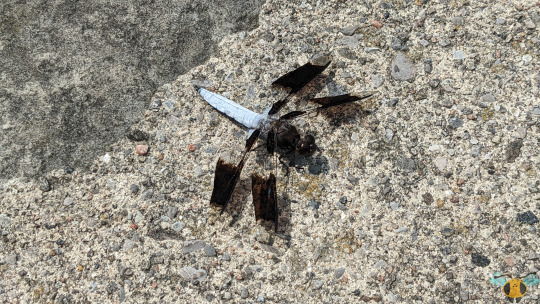
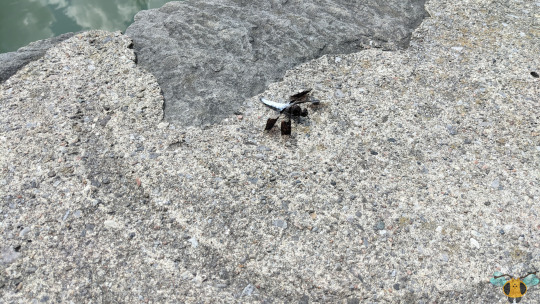

Whitetail Dragonfly - Plathemis lydia
As expected, the insects of High Park are enjoying their summer! With flowers everywhere, balmy temperatures and lush wilderness, what's not to love? Nowhere is this more apparent than by High Park's little ponds and Grenadier Pond, where the Dragonflies hunt other insects and sun themselves during the day. They're having a great time, but unfortunately this makes photography tough. Bide your time, and you may get an opportunity to capture photos of a specimen landing on a piece of vegetation or a man-made structure as it rests. With a specimen like this one, the pruinose (white wax-powder) coating along the abdomen makes an aged gentlemen, such as this one, hard to miss (even from a distance). Even mroe beautiful are the colored parts of the wings, near the base. However, just as you can see his lovely features, he sees you back with those large compound eyes. The eyes are quite remarkable, but make sneaking up on them virtually impossible, so either have a net on hand or chase your Dragonflies slowly. If they need to rest, they may not fly far away the first time; this specimen took off for the far side of the pond after 3 attempts. He was always a step ahead of me, but that's how Dragonflies work.
Visional awareness and acuity are some of their greatest assets, in conjunction with their tremendous flight capabilities and aerial prowess, of course. Consider this however, and this goes for most (if not all) Dragonflies, not just Skimmers like the individual here: Dragonfly eyes are such a great asset, that there's little room on their face for long antennae. Given their position as well - between the eyes and the facial plate - long antennae may prove to be cumbersome and intrusive during flight, especially for a speedy, flying predator. That being said, the reduced antennae that Odonates possess do have (at least) 2 crucial functions: catching scents the air, and gauging air speed during flight. Besides, a Dragonfly can feel the insects or objects they catch using its legs and strong mandibles! However, the insect world presents amazing creatures and evolutionary trajectories, so it's not impossible to find a fast-flying, long-antenna-ed, predatory insect. Though the head and wing venation makes Dragonflies distinct, if you stumble upon a large-eyed, net-winged, Dragonfly-like creature with long antennae, you may have discovered an Owlfly (one of the branches of Neuroptera)!
Pictures were taken on August 9, 2023 in High Park with a Google Pixel 4.
#jonny’s insect catalogue#ontario insect#dragonfly#whitetail dragonfly#skimmer dragonfly#odonata#insect#toronto#high park#august2023#2023#nature#entomology#invertebrates
26 notes
·
View notes
Text




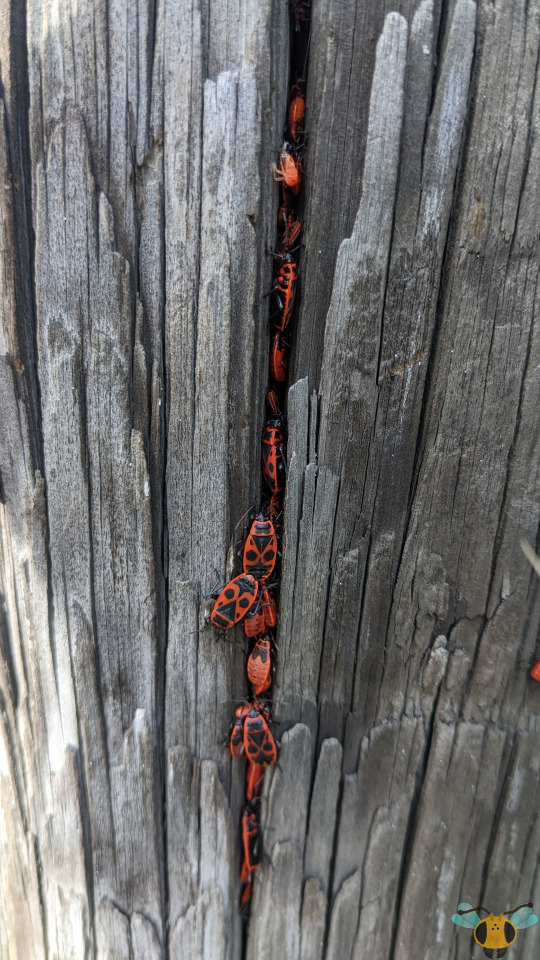




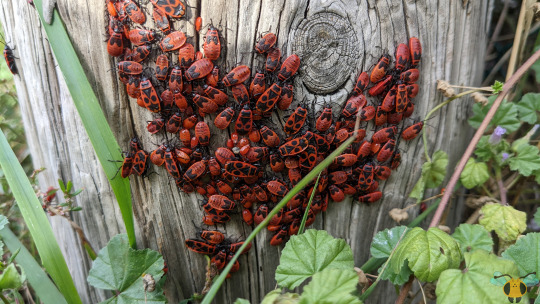
Firebug (aggregation) - Pyrrhocoris apterus
In previous posts featuring this insect, the aggregations I've found were near the of a tree (and some of the surrounding plants) or nearby in the surrounding grasses. These Red Bugs had gathered to absorb the setting sun's heat and to search for seeds (their primary form of nutrition) and while aggregated they enjoy safety and comfort in numbers. All this is nothing new, but where urban environments and nature come together, the Common Firebug may be found in strange places. In today's post, the aggregations found here were either on or near a wooden utility pole! A while back, I noticed a similar event with a similar looking insect: the Eastern Boxelder Bug. Both insects had mistaken a piece of human construction for a tree. Looking at it from an insect's perspective, a large wooden object may very well be mistaken for tree, especially if it has similar scent cues still attached to it. A utility pole unfortunately cannot be used as a food source, but does have potential to act as a shelter from the elements or a sunning location. For the former use (as can be seen from Pictures 5 and 8), as many individuals as possible can cram into the cracks and hide away, similar to the recesses and holes of trees (similar behavior also occurs when they find their way inside a house).
Firebugs would have to rely on other creatures to expend the crevices in order to fit every Bug in the aggregation, but alas, nature is survival of the fittest. What may benefit the Firebugs more is a eusocial/colony structure whereby the younger nymphs hide away in the woody voids while the adults monitor and search for food. While not eusocial in any way, there are small inklings of such a system in the aggregations. If you look closely, your attention may be drawn more to the spotted, larger and redder adults and not the smaller nymphs that try and hide beneath them. Meanwhile, loose aggregations and single Firebugs scamper about on stone and concrete looking for a source of food and shelter. What can start as one individual in an area can quickly turn into many individuals gathering in an area thanks to potent pheromones. However, different pheromones from this insect can also cause aggregations to separate and scatter. This may be useful as a defense, but likely has more value in use for after mating (for egg dispersal) or if an aggregation grows too large and food sources are in short supply. With reduced wings to prevent flying away (in most cases) personal stuff is all the more important, and it's furthermore great that this specie can run very quickly should an aggregation need to suddenly form or disperse.
Pictures of individuals or loose aggregations were taken on June 16 and August 5, 2022 with a Google Pixel 4. Pictures of the large aggregations were taken on October 1, 2022 with a Google Pixel 4.
#jonny’s insect catalogue#ontario insect#firebug#firebug aggregation#common firebug#red bug#hemiptera#heteroptera#true bug#insect#aggregation#insect aggregation#toronto#june2022#august2022#october2022#2022#entomology#nature#invertebrates
10 notes
·
View notes
Text



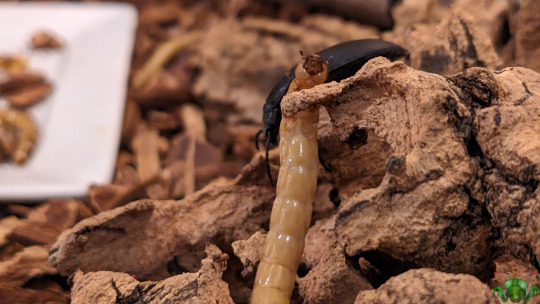


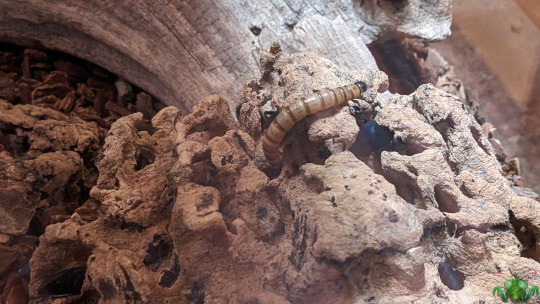
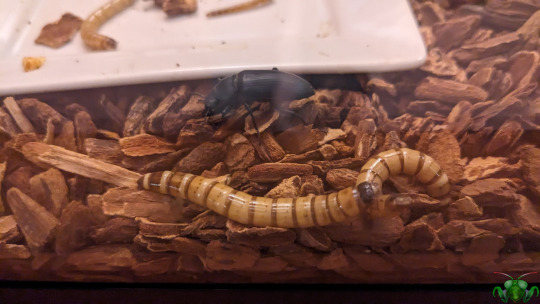
Zophobas Darkling Beetle (Superworm) - Zophobas morio
There's just something about today that warrants the showcase of "worms" and this particular specie of Darkling Beetle. Of course, the "worms" here aren't actual worms (referring to Annelids), there are the larval form of the armored individuals. This specie has already been covered before in detail; these pictures are actually part of the same set from a previous December post, so the information provided there also applies here. Although larvae and adults live together in the same terrarium, the latter will not eat the former. At least not while food is plentiful and there are no carcasses from expired Superworms to consider. Larvae however, are much more likely to eat each other, especially if some molt into defenseless pupae. Under the circumstances here, they aren't likely to molt while food and water are plentiful and many larvae are clustered together. Only when isolated from each other or placed in a secure environment will a larva turn into a pupa.
There are none here, but the Z. morio pupa are brownish-white, shrimp-shaped pupa and they eventually metamorphose into the adult Beetles you see before you. It's a staggering change, but the insect world is full of many astounding transformations as larvae/nymphs grow large, mature, and sprout wings. While the adult Beetles is heavily armored and can move around with greater locomotion, security and grip, they do lose certain advantages from their time as larvae. They can easily wriggle and navigate through the earth (or wood chips here), fit into small tunnels without needing to chew and expand them, and contour themselves along a surface as sleek-formed grubs. While these advantages may be missed, what is gained in adulthood (including the abilities to fly and reproduce) is more than worth it. If they would be told what was in store for them by an insect "Herald of the Change", would they accept?
Pictures were taken on December 19, 2023 with a Google Pixel 4. Check out the many insects of the Royal Ontario Museum if you happen to be in town.
#jonny’s insect catalogue#ontario insect#beetle#beetle grub#zophobas darkling beetle#zophobas darkling beetle larva#superworm#darkling beetle#coleoptera#ROM insect#royal ontario museum#insect#toronto#december2023#2023#nature#entomology#insect showcase#bug box#insect exhibit#dune part two#dune part 2#dune 2#atreides#invertebrates
8 notes
·
View notes
Text




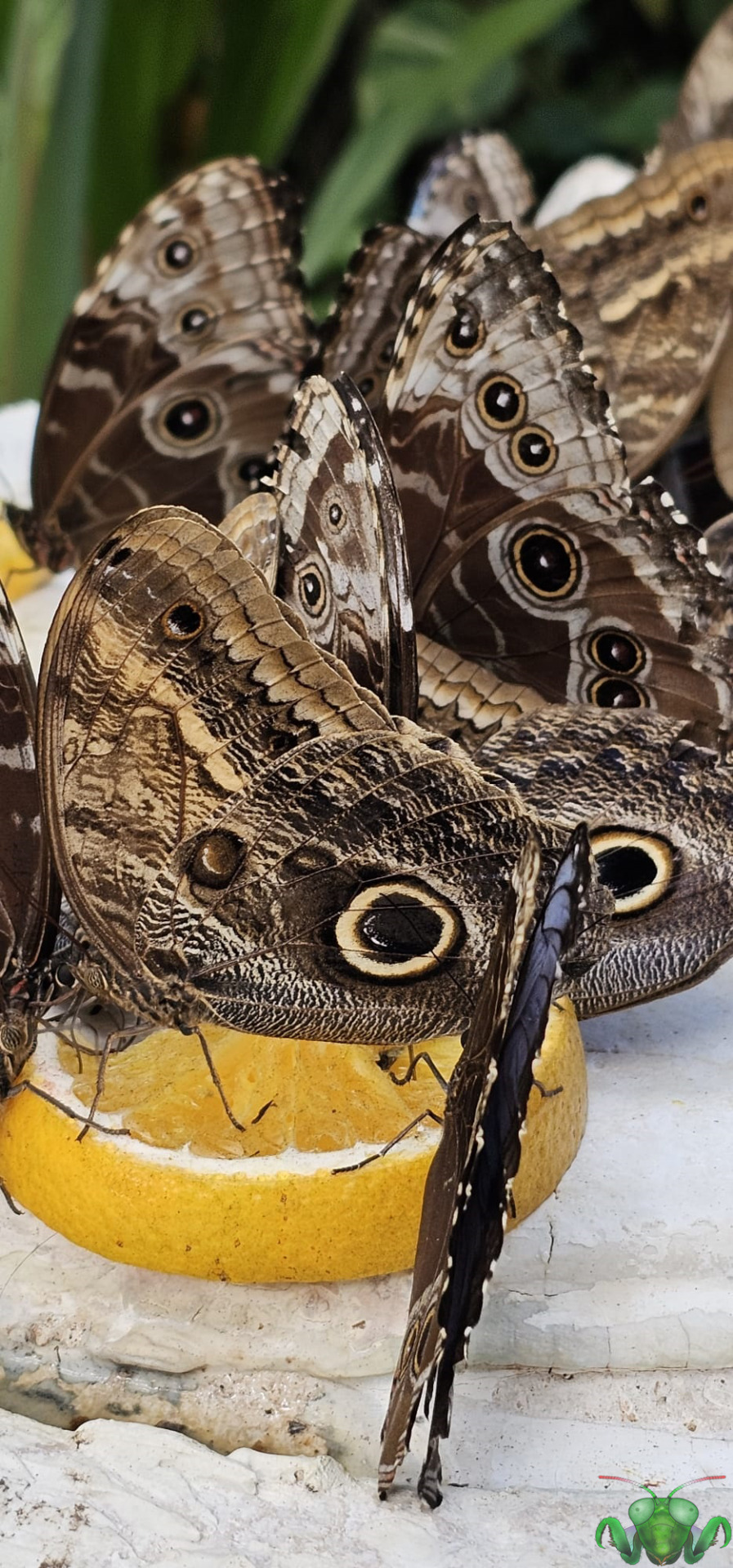

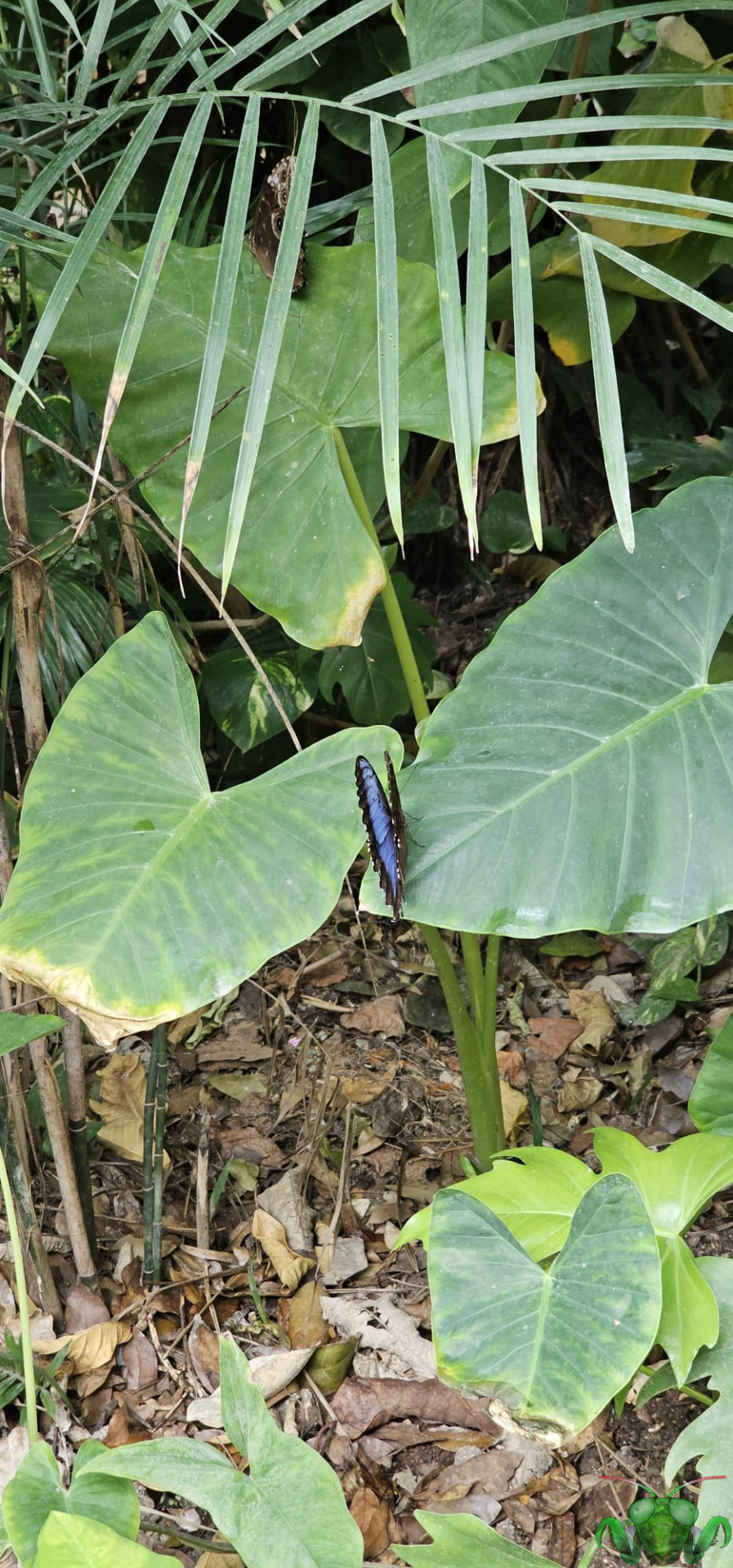

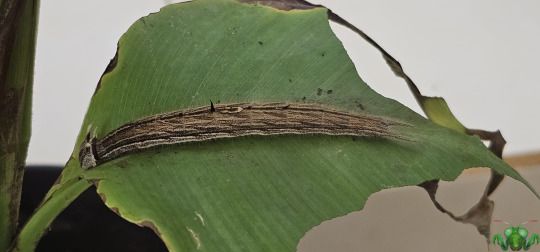
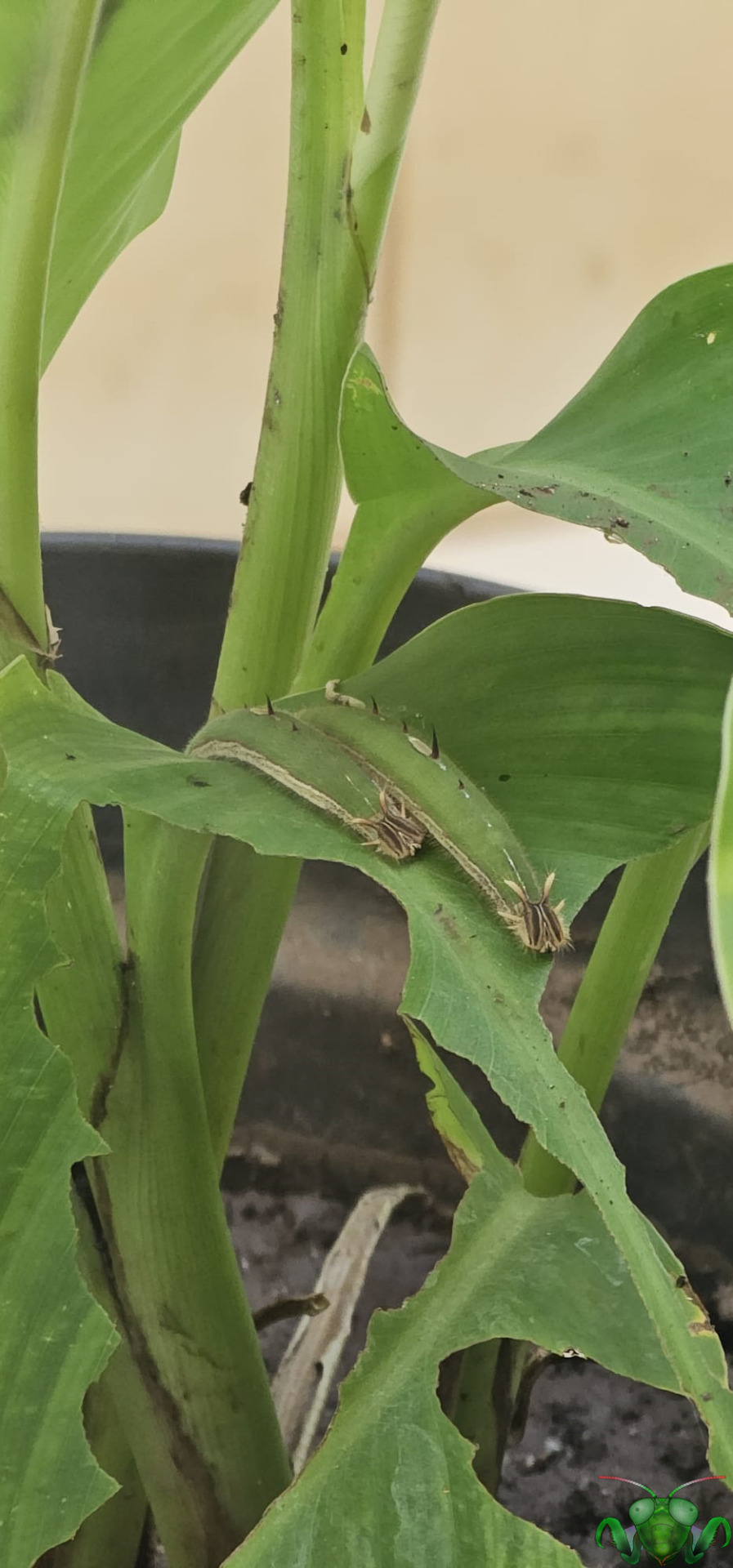
Brush-Footed Butterfly Snack Time & Hungry Owl Caterpillars
Our time observing the Butterflies of Mexico comes to a close with a delight sight of many individuals coming in to land for a citrus-filled snack! In this Butterfly garden, snacks are placed to encourage photography and closer glimpses at these beautiful insects. Handling is discouraged of course, but I'd be willing to bet that these Butterflies wouldn't mind flying over if you were close enough and holding some fruit. Using the orange slices, you can get a sense of scale for these scale-winged insects, and all things considered they are quite large and if they were to open their wings, their wingspan would be impressive! At this snack station, there are (at least) 3 different species of Butterflies congregating and sipping with their proboscises. Though different in many ways, these Brush-Footed Butterflies have one beautiful thing in common: their drab/mottled colored wings conceal vibrant colors on their dorsal side, aiding their survivability via cryptic camouflage. See if you can identify which specie is which.
The most conspicuous of these 3 are the Giant Owl Butterflies (Caligo telamonius), so named because of their large eye-spots on their hindwing's underside. Their cryptic colors combined with their dusk flying allows them to fly around with low risk of bird attack. And if a bird does attack, the eye-spots make a handy decoy. The hypothesis that the eye-spots deter predators by resembling a predators' eyes has been called into question. It's dorsal side features white, blue and black wings.
My dear friend was also able to find some Giant Owl Caterpillars among the plants. With the horn-like structures on their faces, the lines along their body and their spiny protrusions, they remind me of dragons. The wrigglers here appear to be enjoying Musa plants (the leaves appear similar to those of banana trees, one of which my family has had before). The green individuals appear to be the further developed instar since the spines are more prominent and far larger.
The individuals with brown and white wings featuring many ring-patterned spots are actually the Blue Morpho (Morpho peleides), one of the most iconic and iridescent-winged Butterflies. A few individuals here actually showcase their blue dorsal side (see Pictures 2, 3 and 7). Amazingly, their scale color is not caused by pigmentation of the scale, but rather the scale's prismatic qualities (a phenomenon known as structural color) which are stacked, resulting in entering light wavelengths manifesting only the blue wavelength of light.
Finally, try and spot the One-Spotted Preponas (Archaeoprepona demophon). These were the hardest to identify since they blend in amongst their larger friends and their tan-colored wings would make them difficult to see in the wild. What made the difference for me was the curvature along a vein in the hindwing. In comparison to their conspicuous fruit-mates, they aren't so distracting. However, up close there's quite a bit to enjoy. Looking at pictures other photographers have taken, they have a pink proboscis and a stunning teal-blue and black pattern on their dorsal wings.
Pictures were taken on February 11, 2024 in Mexico with a Samsung Galaxy S23 Ultra.
#jonny’s insect catalogue#giant owl butterfly#one spotted prepona butterfly#blue morpho butterfly#giant owl butterfly caterpillar#butterfly#caterpillar#giant owl caterpillar#one spotted prepona#blue morpho#brush footed butterfly#lepidoptera#insect#mexico#february2024#2024#nature#entomology#invertebrates
8 notes
·
View notes
Text
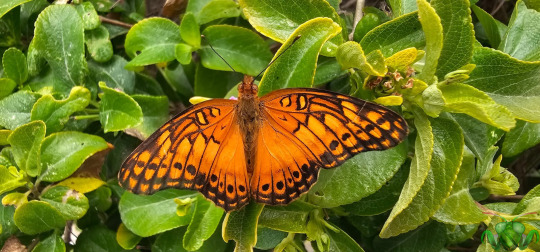
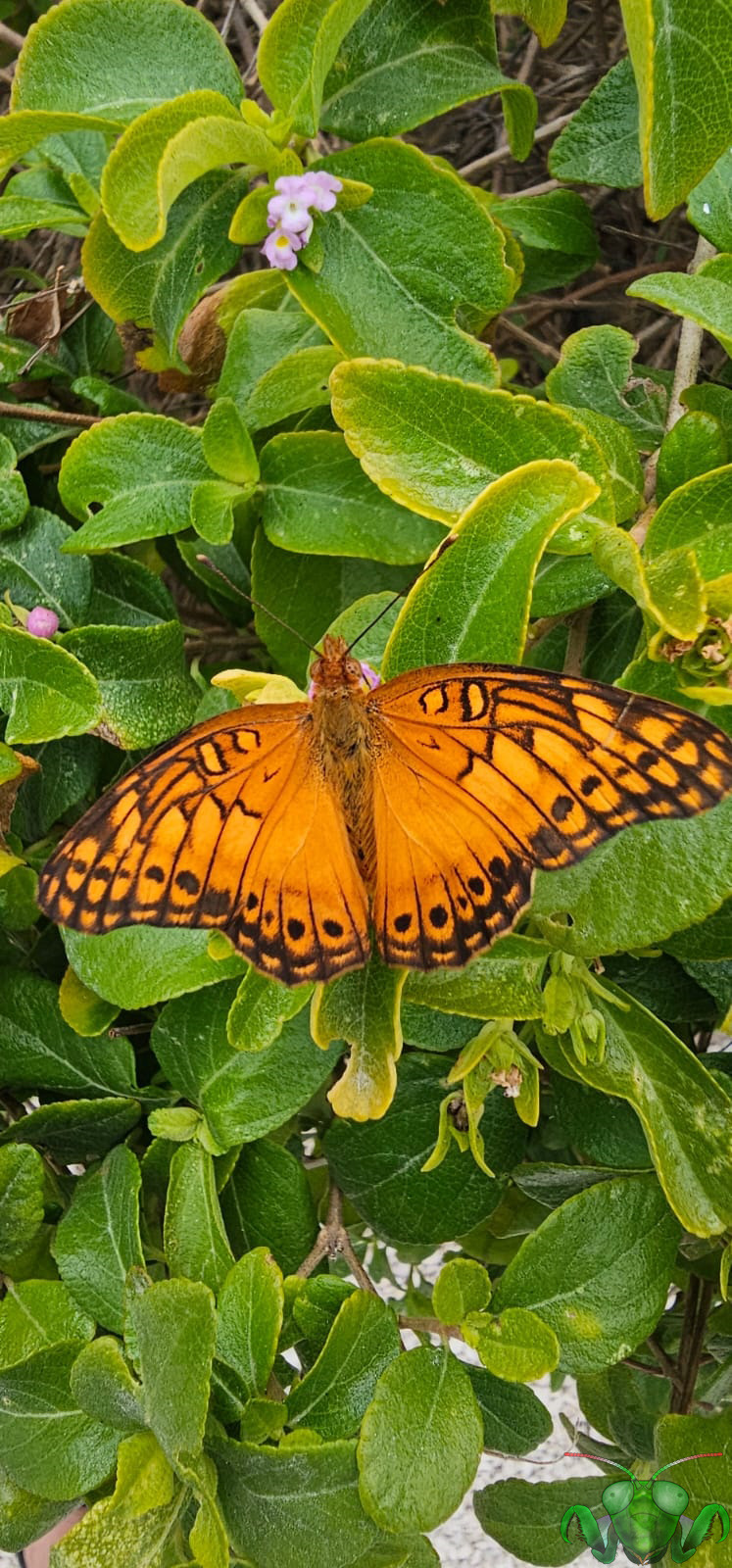
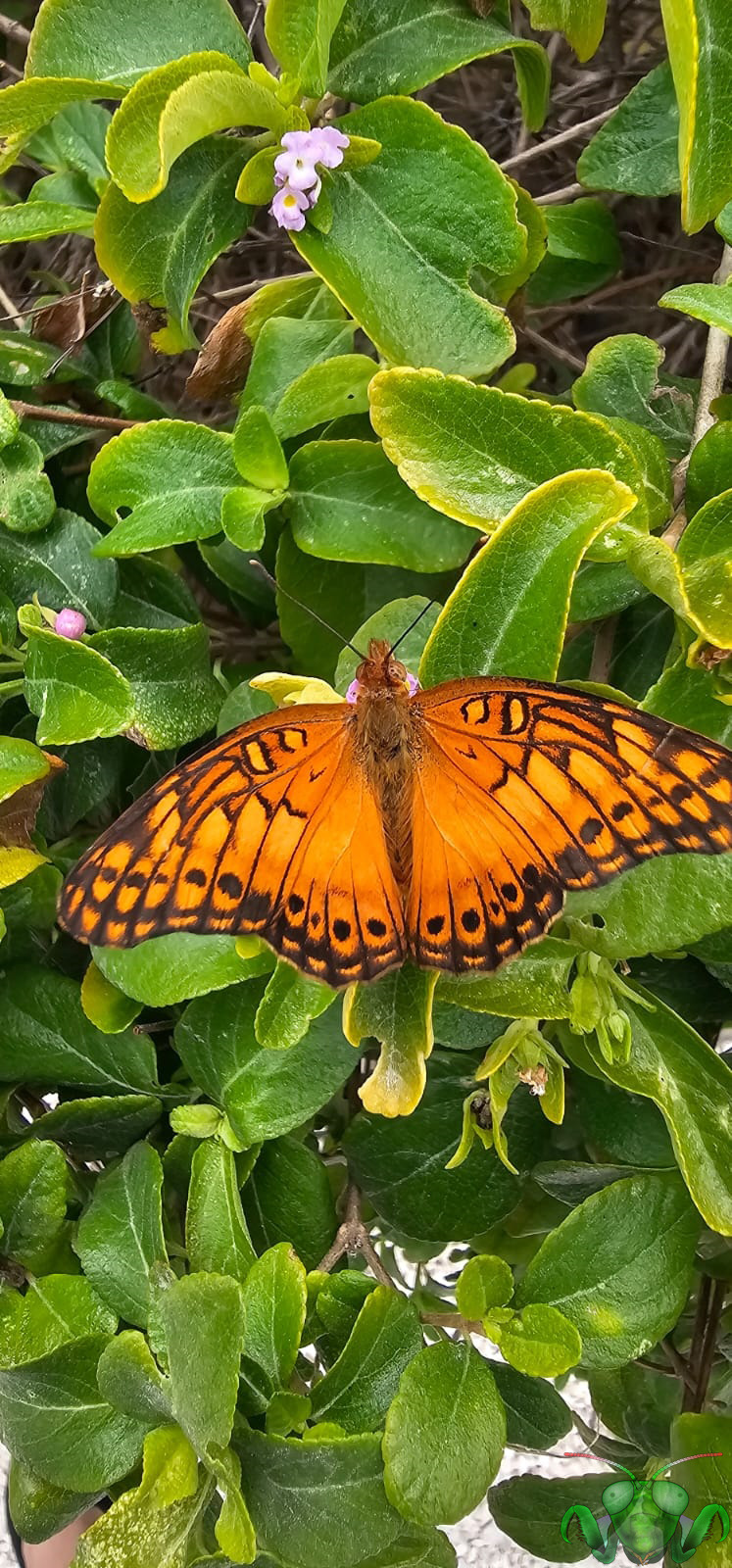
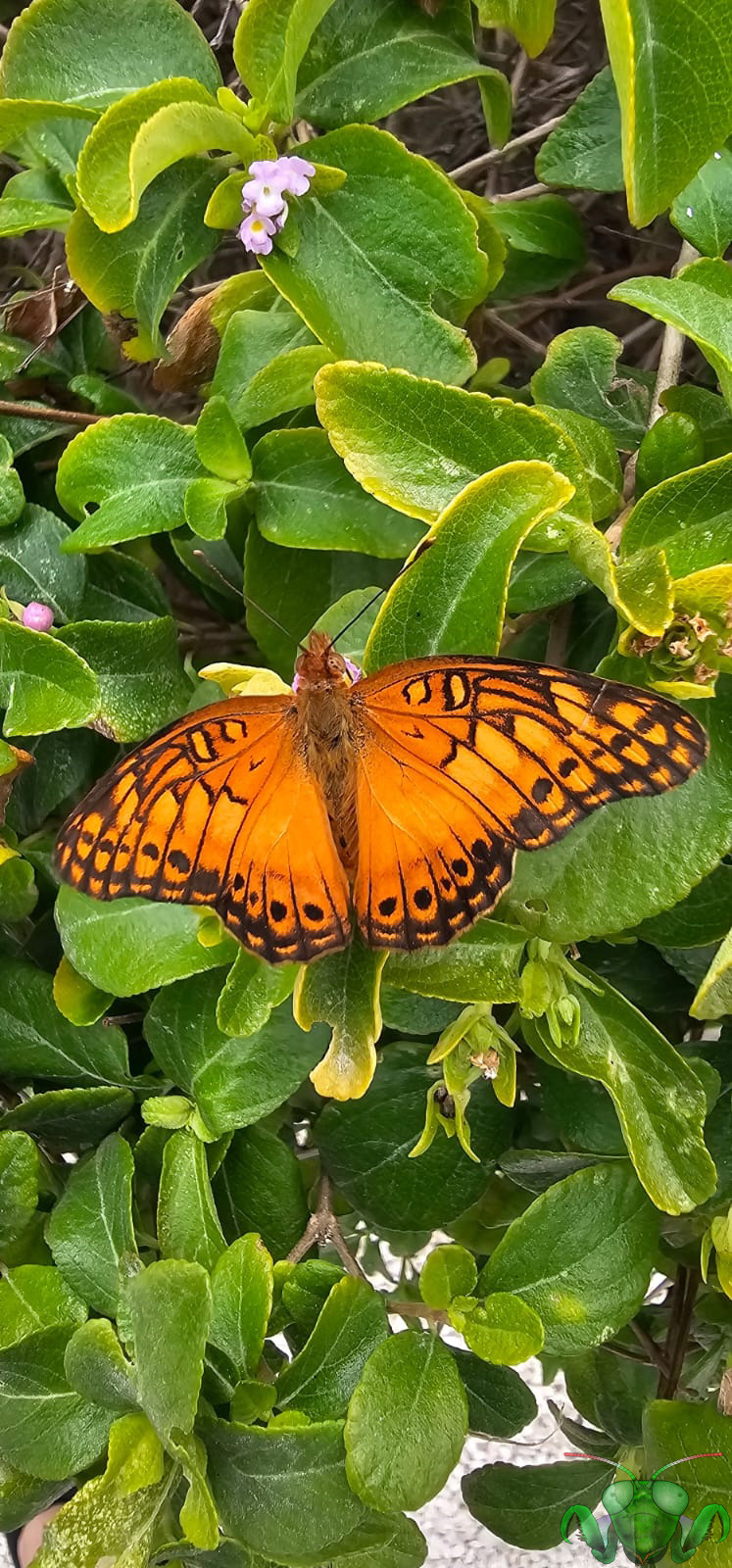
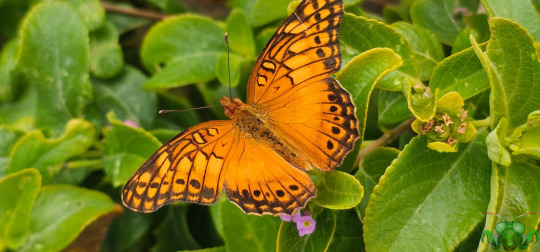

Mexican Fritillary - Euptoieta hegesia
I'm absolutely overjoyed to share these beautiful Butterfly pictures! Not only is the insect in question a real stunner, but these images also represent the first close-ups of the ornate and elegant Fritillary Butterflies (Tribe Argynnini) on this blog. In general and from my own experience, Fritillaries are incredibly quick to flee if they sense danger approaching! They only ever seem to land when they investigate flowers, but otherwise keep their distance. In fact, the genus "Euptoieta" name originates from a Greek word meaning 'easily scared'. Prior to this, I've only been able to share one image of my own photography from High Park, and even then it was taken from far away and merely included as a comparison photo to Fritillary pictures shared with me by a dear friend on her yearlong Asia trip (who was available to get much closer than I did). With these pictures from a very dear friend enjoying a Mexico vacation (for which I'm very thankful for), the beauty and detail of these royal and gilded Butterflies can be observed gloriously. The sole exception here being the legs which are concealed by the wings. Just keep in mind that as a Brush-Footed Butterfly (family Nymphalidae)* it only has 4 legs in use for walking and landing.
As this Butterfly's common name suggests, its range includes Mexico where it can be seen year-round due to the favorably warm weather. It can also apparently be found in the states of Texas and Arizona (and occasionally Florida) in the latter half of the year and has made its way to other tropical areas such as Cuba. When you see a Fritillary Butterfly flying around, no matter where you find it you'll recognize every future Fritillary as soon as you see one. These gorgeous Butterflies are easily recognized by their marvelous wings, the tops of which are laced with orange scales and accented with dark striped patterns and spots; the undersides tend to have large white or silvery spots. The Mexican Fritillary is a slight exception to this rule as the underside of its wings (not seen here) have a mostly mottled appearance similar to autumn leaves with a small section of vibrant orange featuring white patches on the forewing. Moreover, this Butterfly has a bare, pure orange area on the distal section of its hindwings (where the wings meet the body). Keep an eye out for this bare section of bright orange scales: it is key for identifying this specie if you spot a Fritillary in the south-US/Mexico area. The similar looking Variegated Fritillary (E. claudia) has a completed marking pattern across its hindwings and tends to be a more golden orange rather than the saturated orange of E. hegesia. The two species are much easier to tell apart in adulthood than when enjoying leaves as Caterpillars!
*Note: In the classification hierarchy of taxonomy, remember that Family is ordered before Tribe (which itself comes before Genus). As such, all Fritillaries are Brush-Footed. Their wings are among the most magnificent of all Brush-Footed Butterflies, wouldn't you say? Although...the Monarch is still the most iconic of all.
Pictures were taken on February 11, 2024 in Mexico with a Samsung Galaxy S23 Ultra.
#jonny’s insect catalogue#insect#butterfly#mexican fritillary#fritillary butterfly#lepidoptera#brushed footed butterfly#mexico#2024#february2024#nature#entomology#invertebrates
8 notes
·
View notes
Text
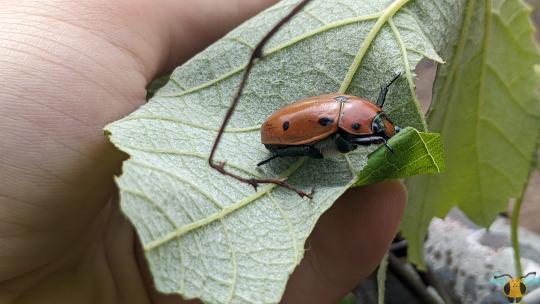
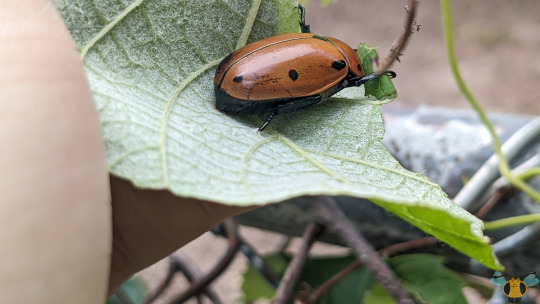

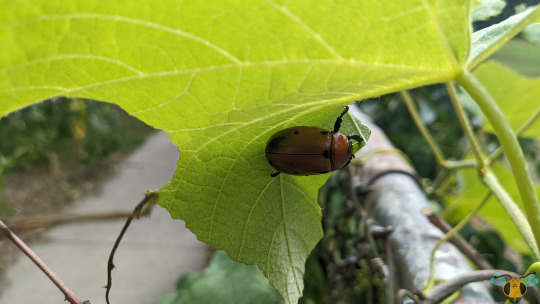
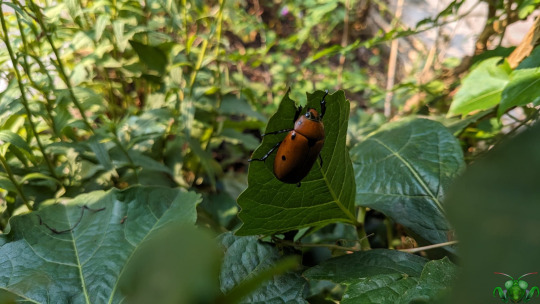
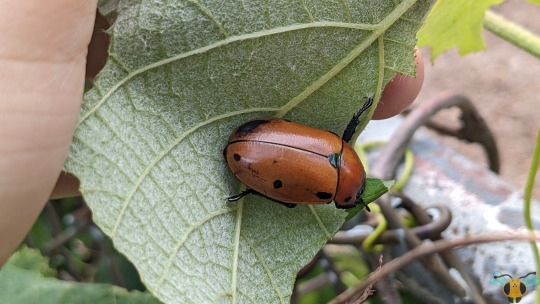
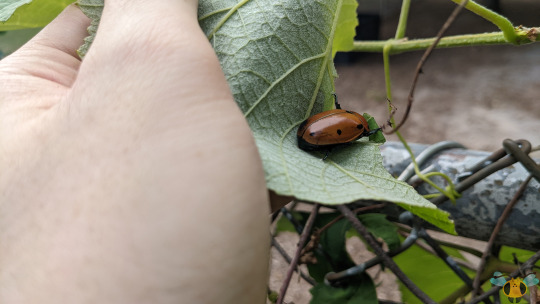
Grapevine Beetle - Pelidnota punctata
My mother found this delectable insect in the front yard last year (Pictures 3 and 5), and seeing it again reminded me that I still have a few pictures from the year 2022 to share as well. Even though I've only seen this insect once before, I'm drawn to it and it's berry-like form. Among the large-sized Beetles, it's definitely one of the cuter specimens being smooth and rounded. Such as it is when you're a Chafer Beetle and you need to support that armored body with a steady diet of leaves. Within both image sets here, the individuals photographed did seem to be eating vine-based plants that are likely not true grapes, but could very well be in the Vitus genus, but I cannot confirm at the moment as I am not a botanist. What I can confirm is this is indeed a Grapevine Beetle and not any of the few look-a-like insects that could be confused with it. One such insect that seems to pop up in that discussion is the Goldsmith Beetle (Cotalpa lanigera), an iridescent fellow Scarab that may be mistaken for the Grapevine's yellow-colored individuals that lack spots and have brown-colored legs. A quick but detailed examination between the two should be enough to discern them where their habitat ranges overlap. Having detailed a lot of this Beetle's behaviors and preferences in its first post on this blog, I'd like to draw your attention to some physical characteristics for the second half of this post.
In particular, I'd like to focus on this Beetle's legs. Insects and legs go hand-in-hand given they have 6 of them and they come in many shapes and sizes all suited for different adaptations. As such, unless they are unusually different (e.g. Mantis raptorial forearms) they can be taken for granted. However, since the legs of this specie are distinctive to its subfamily (Rutelinae - the Shining Cafers). The Scarabs within that subfamily have tarsal claws (the foot claws) that are independently moveable and are unequal in size (one is slightly thicker and larger). Compare this to other Scarabs such as Rhino Beetles that have 2 fixed claws on their tarsus. For the Grapevine Beetle these claws are very prominent (see Pictures 3 and 7) and may offer an advantage for climbing and grasping when navigating vines. Moreover, there are modifications made to the tibiae, which are thickened and lined with bumpy protrusions. There is also a long spike at the end near the leg. These features (when compared against other Beetles) may help make digging easier which could benefit how easier this Beetle can have a suitable egg-laying site ready.
Pictures were taken on September 7, 2022 with a Google Pixel 4 and on August 10, 2023 by my mother with a Pixel 4a (marked with the Mantis Logo).
#jonny’s insect catalogue#ontario insect#beetle#grapevine beetle#scarab beetle#coleoptera#chafer beetle#insect#toronto#september2022#2022#august2023#2023#nature#entomology#invertebrates
13 notes
·
View notes
Text
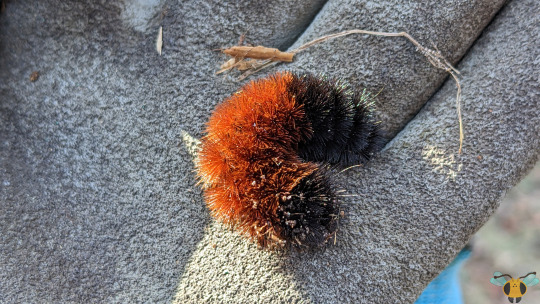

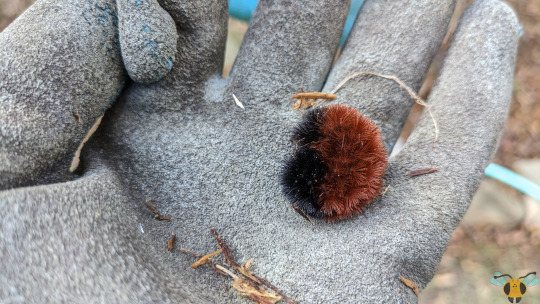
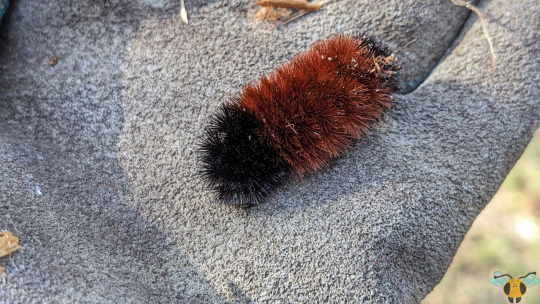
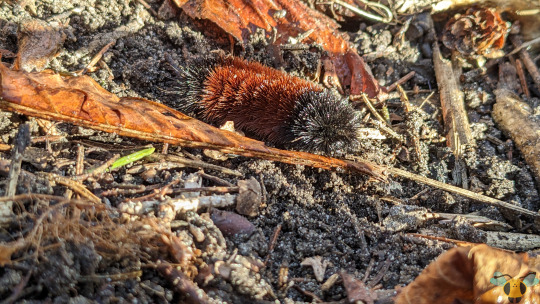


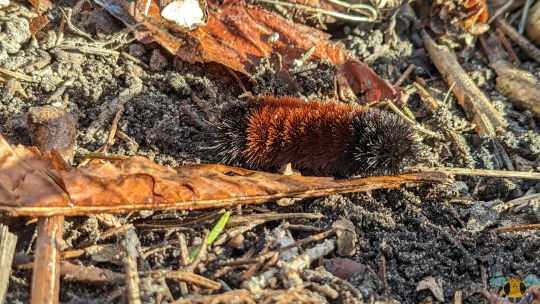


Isabella Tiger Moth Caterpillar - Pyrrharctia isabella
Wednesday was a spectacular day in terms of temperature, almost feeling like summer compared to spring! In my area, flowers have begun to open, the days are getting warmer and sunnier, and spring truly feels like it's here. With that, my family and I took a day to clean up the backyard after a sporadic winter and round up errant leaves and fallen branches from some of the snowfall and winds from winter. It was in this cleanup that my first insect of 2024 was found, that being this fuzzy, ticklish Caterpillar from underneath fallen leaves. I'm always careful to look for hidden residents of the yard like this autumn brood individual. Woolly Bears born in the autumn will eat what they can while plants are plentiful to reach their final instar and then disappear into leaf litter or soil before winter arrives and hibernate until more favorable temperatures. The layers of plants they nestle beneath provide insulation from the worst of cold weather and snow.
When warm weather returns, these wrigglers thaw out and will become Moths with the arrival of spring. With Wednesday's warmth, this fluffy individual was likely active but got caught up as the leaves were shoveled, and took on its balled-up posture to protect its vulnerable underbelly. If you find a specimen like this one, all it takes is a bit of sunshine and a lack of agitation for the ball to unfurl and begin exploring you. After taking pictures (see Picture 10), I placed this Caterpillar back in a sunny garden spot and concealed it with fallen leaves. Currently, the tools for success for this individual would be a quick meal from any healthy vegetation (if needed) and then a safe area to form a cocoon around itself from debris and grasses. With 2 weeks to 1 month, a dazzling orange Moth will emerge, and hopefully that's a great indication that Toronto has officially entered spring without any caveats.
Pictures were taken on March 13, 2024 with a Google Pixel 4. This post is also counted as a milestone as I've received the notification that the blog's posts have received over 500 reblogs. To everyone who enjoys these insects and shares them with others, I offer my sincerest thanks. I couldn't do this without you.
#jonny’s insect catalogue#ontario insect#caterpillar#isabella tiger moth#woolly bear caterpillar#isabella tiger moth caterpillar#moth#insect#lepidoptera#toronto#march2024#2024#nature#entomology#milestone#500 reblogs#500reblogs#invertebrates
7 notes
·
View notes